Itsukushima Island, located in western Japan, is known for its beautiful shrine and torii gate that appears to float on the water. However, it is also home to a diverse range of bird species, making it a popular destination for birdwatching enthusiasts.
With its natural forests, tidal flats, and surrounding waters, Itsukushima Island provides an ideal habitat for both resident and migratory birds.
This article will take a closer look at the different types of birds found on Itsukushima Island, their characteristics, and the significance of these feathered creatures to the island’s environment and culture.
1. Rock Dove
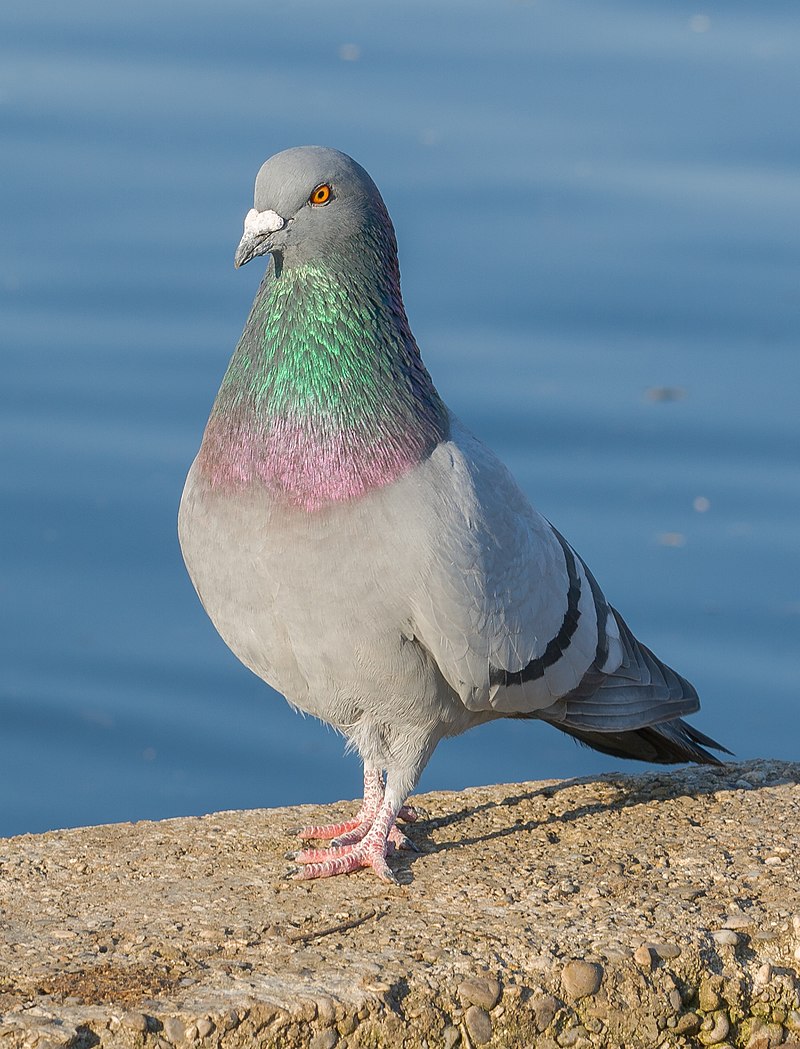
Rock dove, also known as Rock Pigeon or Common Pigeon, is a member of the bird family Columbidae.
It is considered to be an important creature worldwide due to its domestication by humans centuries ago; resulting in the modern-day Domestic pigeon which descends from this species.
Its population has increased over time because some domestic pigeons have escaped captivity and joined wild populations.
The rock dove can most easily be identified by its prominent blue-grey feathers with darker bars on wings and tail along with two black bands on each wing.
They are typically found in large flocks near cliffs or buildings but may also inhabit rural habitats such as open fields and meadows if there’s enough food available for them nearby.
Although they don’t migrate far distances like other birds, their numbers increase significantly during winter months.
When more food sources become available closeby so that they won’t need to travel too far away from home base for nourishment.Scientific classification:
| Kingdom | Animalia |
| Phylum | Chordata |
| Class | Aves |
| Order | Columbiformes |
| Family | Columbidae |
| Genus | Columba |
| Species | C. livia |
Also Featured In: Common Birds in India, Common Birds in the Cities
2. Common Kingfisher
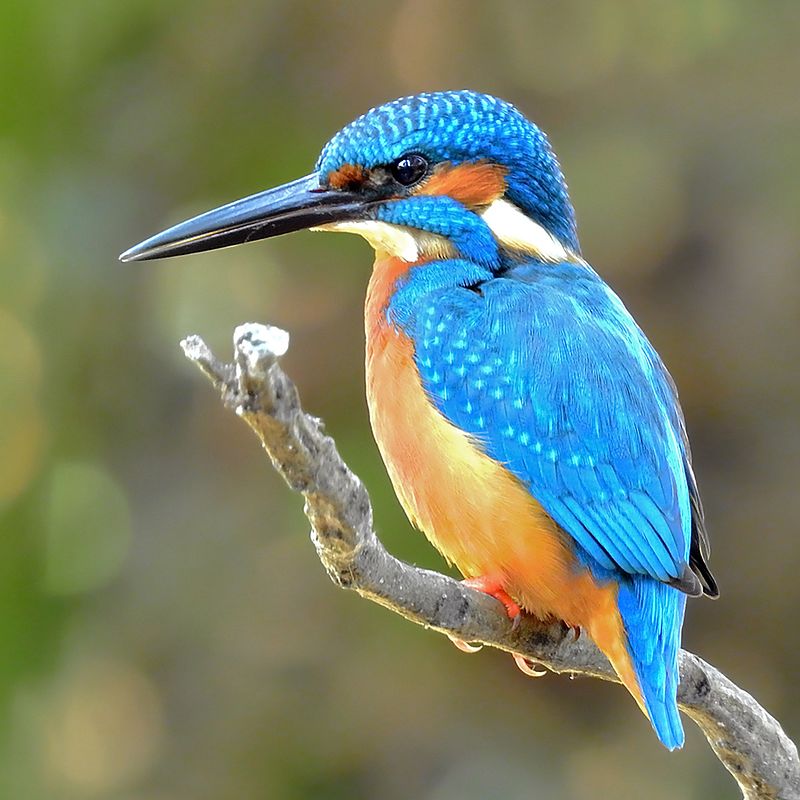
The Common Kingfisher is a small, sparrow-sized bird that can be found across Eurasia and North Africa. It has the typical short tail and large head of kingfishers with seven different subspecies recognized in its range.
They are mainly resident birds but will migrate away during winter when rivers freeze over. The species usually live near bodies of water such as streams or lakes.
Where they hunt for fish by diving from above into the water after spotting their prey below them.
These brightly coloured birds have an unmistakable vibrant blue plumage along with orange underparts and white patches on their wings which makes them easy to recognize amongst other similar looking species.
Their call is loud and shrill making it one of the most recognizable sounds heard around wetlands throughout Europe.Scientific classification:
| Kingdom | Animalia |
| Phylum | Chordata |
| Class | Aves |
| Order | Coraciiformes |
| Family | Alcedinidae |
| Subfamily | Alcedininae |
| Genus | Alcedo |
| Species | A. atthis |
Also Featured In: Ukrainian Birds You Should Know, Most Common Romanian Birds
3. Black Kite
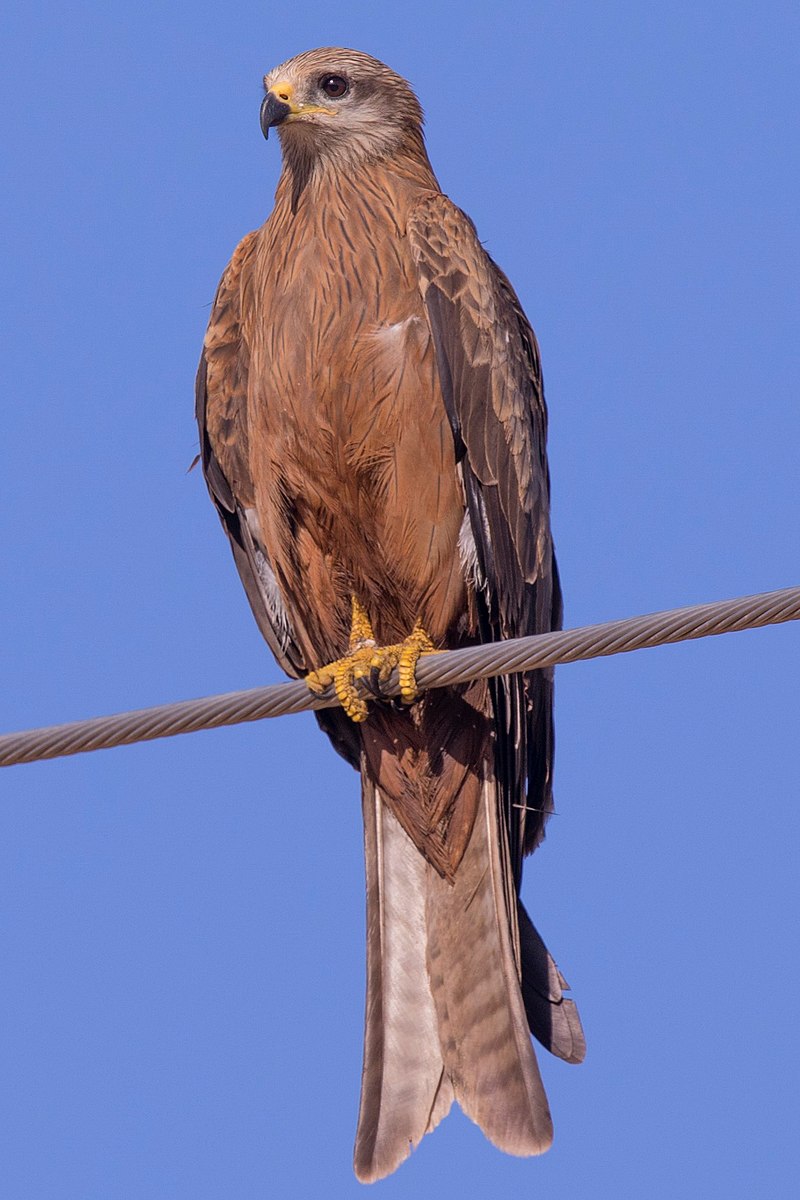
The black kite is one of the most abundant species of diurnal birds of prey in the world, with a global population estimated to be up to 6 million individuals.
It belongs to the family Accipitridae and has medium-sized body size. The wingspan can range from 150 cm – 180cm wide.
They have dark brown feathers on their back and light brown or grey underparts and long forked tails that help it maneuver through.
Its environment while hunting for food like insects, small mammals, reptiles etc., along with scavenging opportunities when available.
Black Kites are found across several continents including Europe, Africa, Asia Minor & Australia where they breed during spring in nests made among trees near wetlands or riversides;
migratory populations move southward away from winter cold temperatures as far east as India & Japan before returning home again next season.Scientific classification:
| Kingdom | Animalia |
| Phylum | Chordata |
| Class | Aves |
| Order | Accipitriformes |
| Family | Accipitridae |
| Genus | Milvus |
| Species | M. migrans |
Also Featured In: Summer Birds that Live around Us, Hong Kong Birds You Need to See
4. Falcated Duck
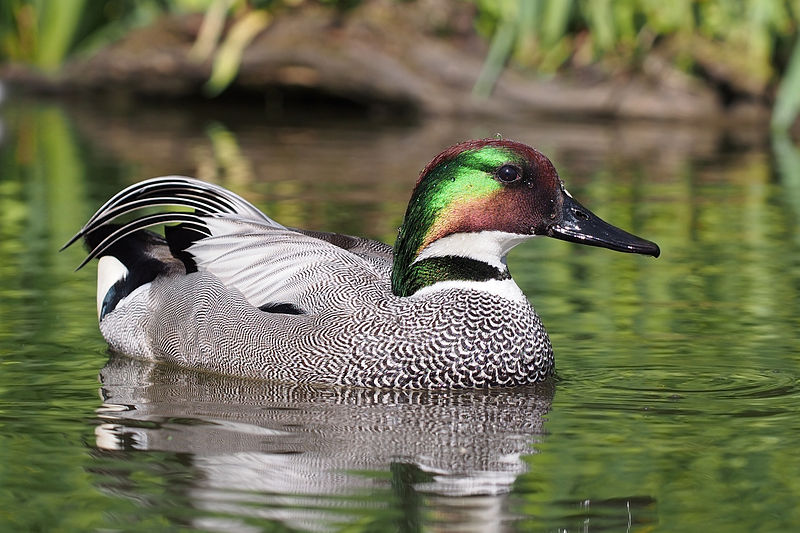
The Falcated Duck is a beautiful species of dabbling duck native to the east Palearctic region. It has a close relationship with both gadwall and wigeons, leading some researchers to assign it its own genus called Mareca in 2009.
The bird stands at approximately 20-25 inches tall and features an orange bill, dark brown head, speckled white/brown body feathers, long tail feathers that are folded up like fans (this gives them their name), yellow legs and feet as well as black eyes.
This majestic creature can be found inhabiting wetlands such as lakes or ponds around East Siberia through North Japan.
During winter months they migrate further south towards India in search of food sources during colder climates. All these characteristics make the Falcated Duck one of nature’s most beautiful works.Scientific classification:
| Kingdom | Animalia |
| Phylum | Chordata |
| Class | Aves |
| Order | Anseriformes |
| Family | Anatidae |
| Genus | Mareca |
| Species | M. falcata |
Also Featured In: Birds Commonly Found in Kyoto, Birds You’ll Find in Hokkaido
5. Gadwall
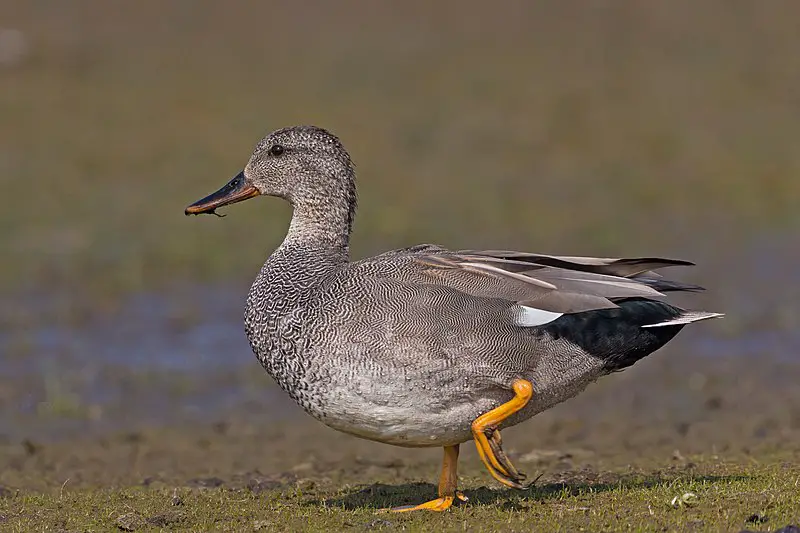
The Gadwall is a species of duck belonging to the Anatidae family. It was first described by Carl Linnaeus in 1758 and DNA studies show that it is closely related to the Falcated Duck, as well as three other Wigeons.
They are quite common and can be found across many parts of North America and Europe.
In terms of appearance, they have light grey bodies with white underbellies, brown wings tipped with black spots, yellowish-orange bills, dark eyes and distinctive chestnut heads which make them easy to identify among other ducks.
They prefer shallow wetlands but also inhabit ponds or lakes during winter migration season where they feed on aquatic plants such as pondweed or water lilies alongside small insects like beetles or dragonflies when available.Scientific classification:
| Kingdom | Animalia |
| Phylum | Chordata |
| Class | Aves |
| Order | Anseriformes |
| Family | Anatidae |
| Genus | Mareca |
| Species | M. strepera |
Also Featured In: Most Popular Bird Species in North America, Belarus Birds You Should Know
6. Eurasian Collared Dove
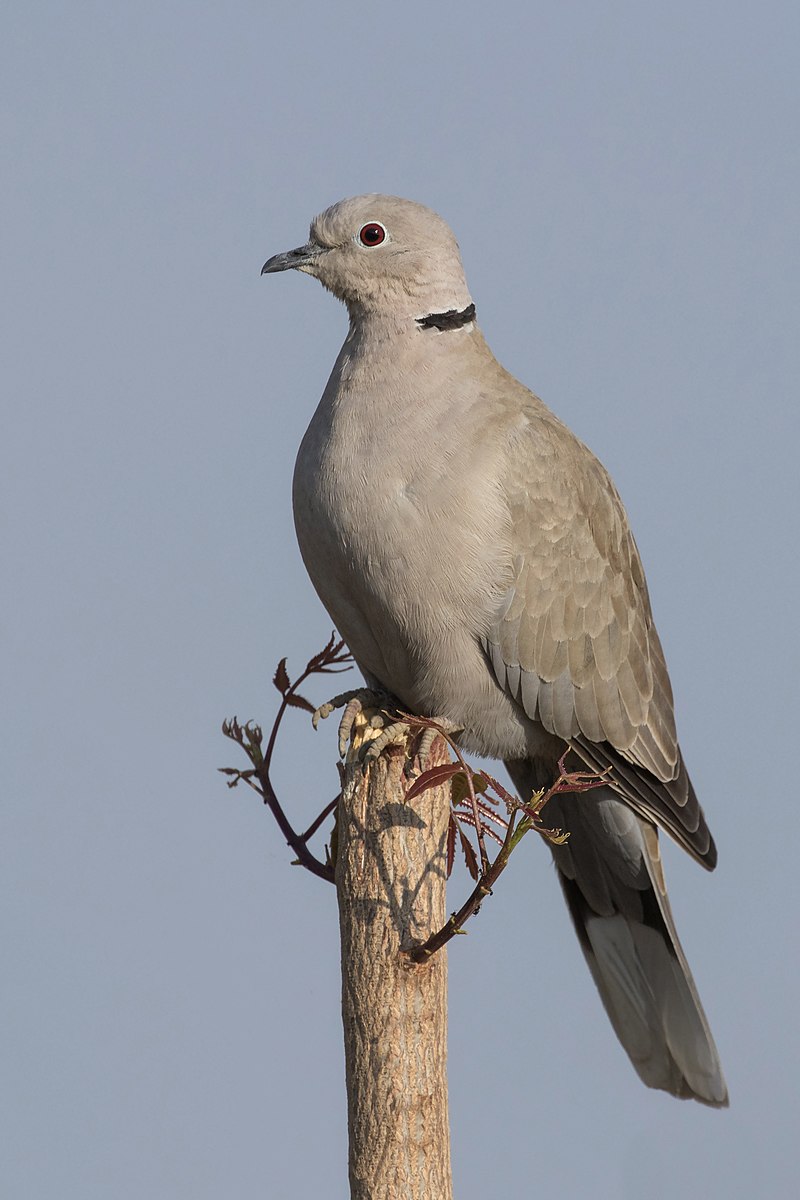
The Eurasian collared dove is a species of bird native to Europe and Asia, with its range expanding through introduction in Japan, North America, and islands in the Caribbean.
It has become so widespread that it is listed as Least Concern on the IUCN Red List. The scientific name for this bird was proposed by Hungarian naturalist Imre Frivaldsz – Columba decaocto.
This beautiful creature typically measures between 33-37 cm from tip to tail feathers, displaying an overall greyish brown plumage; they also have distinctive black half collar around their neck which gives them their common name.
These birds are mainly found inhabiting open woodlands or agricultural lands near human settlements where there’s plenty of food available such as grain fields or gardens where fruits can be eaten off trees.
With a vast global population trend increasing steadily each year these birds make great additions to many backyards throughout the world.Scientific classification:
| Kingdom | Animalia |
| Phylum | Chordata |
| Class | Aves |
| Order | Columbiformes |
| Family | Columbidae |
| Genus | Streptopelia |
| Species | S. decaocto |
Also Featured In: Top Birds Found in Mexico, Birds That Live in Colorado
7. Little Ringed Plover
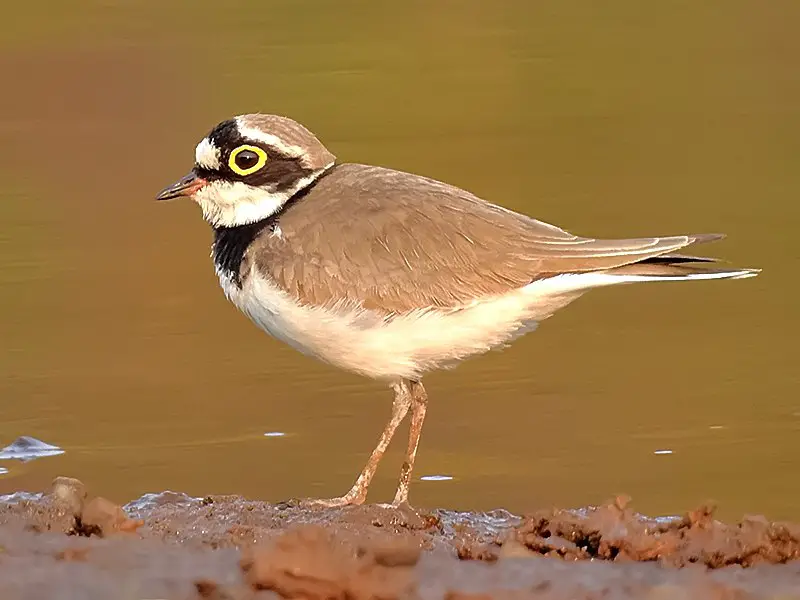
The Little ringed plover is a small species of bird from the genus Charadrius. It has been given its scientific name due to an uncertain origin and yellowish colouring, which was first noted in the fourth century Vulgate Bible.
Native to river valleys across Europe and parts of Asia, this wader prefers areas with soft ground where it can feed on insects or worms.
Its plumage consists mainly of brown tones but during breeding season males will develop a black breast band for courtship displays.
These birds construct shallow nests near waterbodies using pebbles found nearby as well as vegetation such as grasses and mosses to provide camouflage from predators.
The female typically lays three eggs at one time that are incubated by both parents until they hatch after around three weeks before fledging shortly afterwards.Scientific classification:
| Kingdom | Animalia |
| Phylum | Chordata |
| Class | Aves |
| Order | Charadriiformes |
| Family | Charadriidae |
| Genus | Charadrius |
| Species | C. dubius |
Also Featured In: Common Birds in Japan, Common Birds of Portugal
8. Common Sandpiper
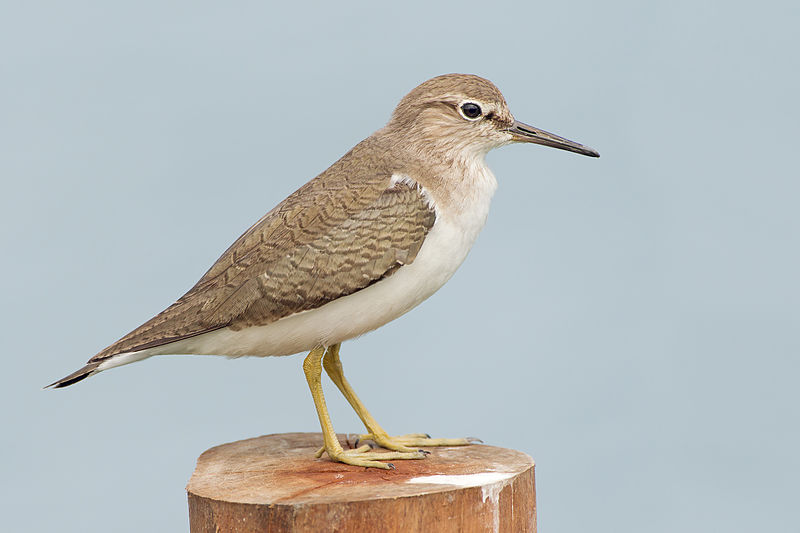
The Common sandpiper (Actitis hypoleucos) is a small Palearctic wader, found in Eurasia and parts of Africa. It can be identified by its brown back, white breast and distinctive black eye-stripe.
In flight it shows broad wings with white underparts and conspicuous dark patches on the upperwings.
These birds live close to water bodies such as rivers or lakes where they feed mainly on insects, crustaceans and molluscs which they find in mudflats.
They are also known to have hybridized with their American sister species – the Spotted Sandpiper (A macularia).
This bird is territorial during breeding season but forms flocks outside of this period when migrating long distances between wintering grounds throughout Europe, North Africa & South West Asia..Scientific classification:
| Kingdom | Animalia |
| Phylum | Chordata |
| Class | Aves |
| Order | Charadriiformes |
| Family | Scolopacidae |
| Genus | Actitis |
| Species | A. hypoleucos |
Also Featured In: Egyptian Birds, Common Estonian Birds
9. Great Cormorant
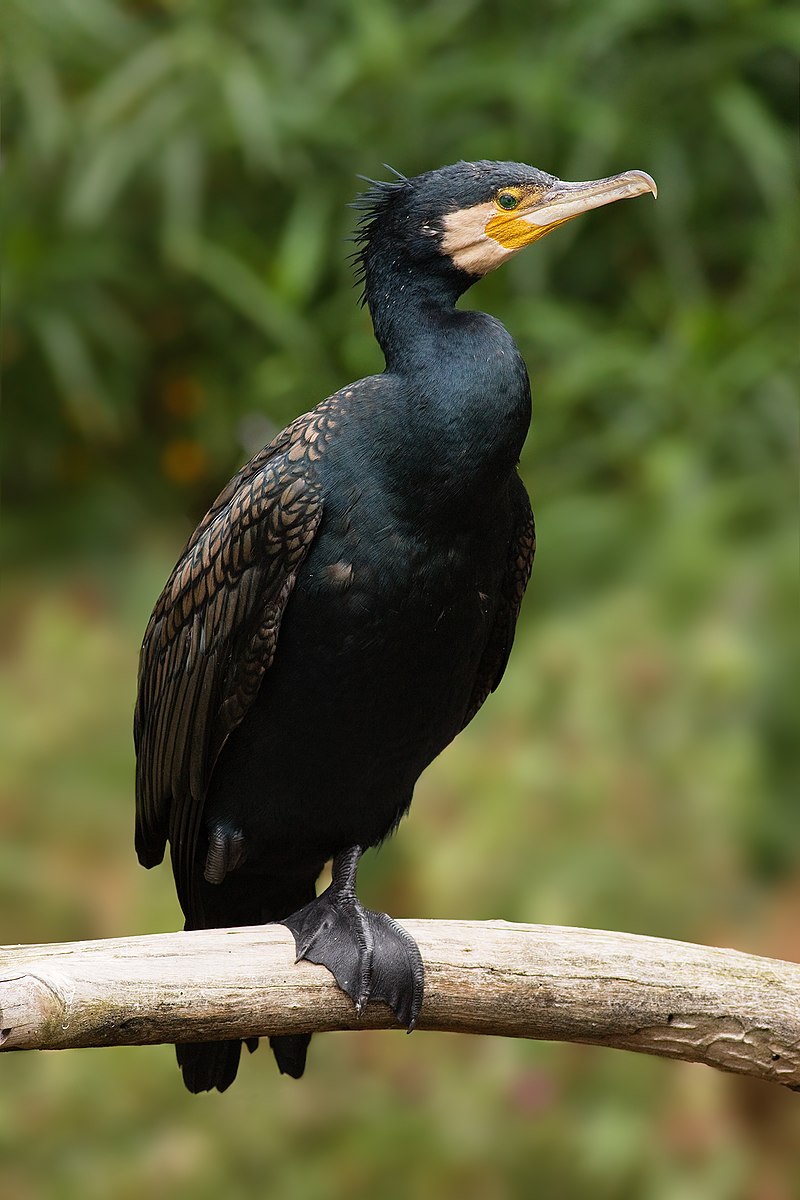
The Great Cormorant is a large seabird belonging to the cormorant family. It has many names, including Black Shag in New Zealand and Large Cormorant in India.
Its striking black feathers make it easy to recognise along coastlines or near bodies of water. The bird can measure up to 1 metre long with a wingspan of around two metres and weighs roughly 3 kilograms.
In flight, its neck is stretched out straight ahead while its bill points downwards – an unmistakable sight for any keen observer.
Cormorants are strong swimmers and excellent divers, frequently going underwater in search of food such as fish or crustaceans that they scavenge from the ocean floor.
They live primarily on coasts but have also been seen inland where there are suitable waterways available – providing another opportunity for nature lovers hoping to catch a glimpse of this impressive species.Scientific classification:
| Kingdom | Animalia |
| Phylum | Chordata |
| Class | Aves |
| Order | Suliformes |
| Family | Phalacrocoracidae |
| Genus | Phalacrocorax |
| Species | P. carbo |
Also Featured In: Native Birds Of Germany, Water Birds Live around Us
10. Great Crested Grebe
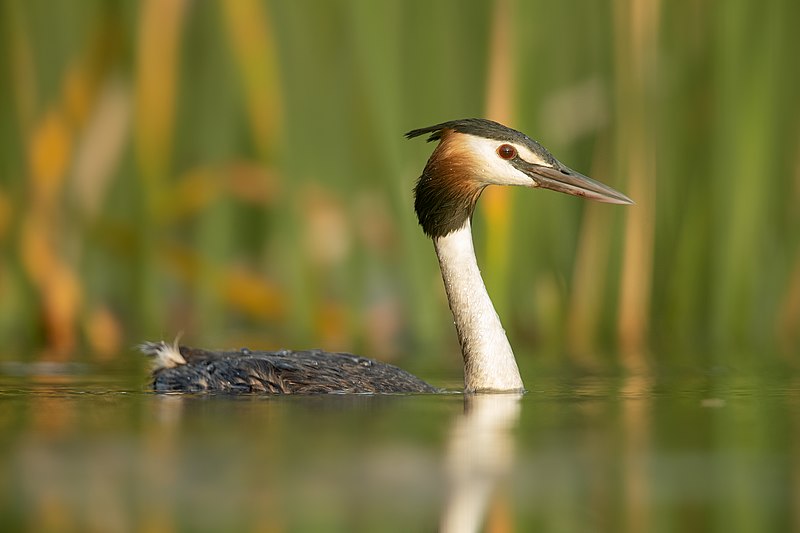
The great crested grebe is a beautiful water bird belonging to the grebe family. It is easily identified by its striking head crest, which it displays during mating rituals.
Originally classified in 1758 by Carl Linnaeus as Colymbus cristatus, this species has since become the type example for all other members of its genus Podiceps.
Great crested grebes are known for their intricate courtship behavior such as synchronized swimming and “head-shaking” motions used to attract mates.
They also possess unique features like red eyes and lobed feet that help them swim efficiently underwater when hunting for food.
The great crested grebe can be found throughout much of Europe, Asia, Africa and Australasia where they inhabit freshwater wetlands or shallow lakeshores with plenty of vegetation nearby to hide from predators while nestingScientific classification:
| Kingdom | Animalia |
| Phylum | Chordata |
| Class | Aves |
| Order | Podicipediformes |
| Family | Podicipedidae |
| Genus | Podiceps |
| Species | P. cristatus |
Also Featured In: Common Birds in London, Common Birds Found near Ishigaki
11. Black-Headed Gull
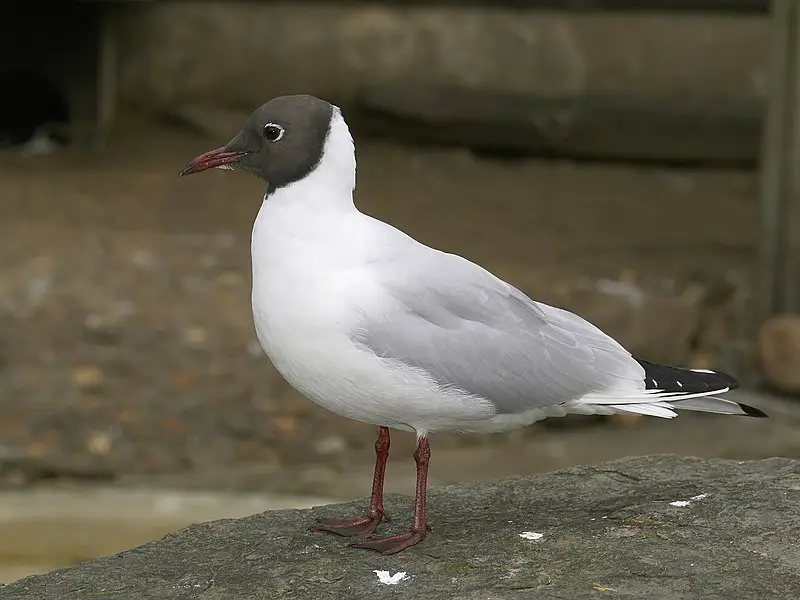
The Black-headed Gull is a small, migratory bird found in much of the Palearctic. It breeds mainly in Europe and coastal eastern Canada but can also be found further west in milder areas.
In North America it’s known as the Common Black-headed Gull.
Its plumage consists of grey on top with white underneath, while its head has a distinctive black cap during breeding season which fades to brown outside of this period.
They are often seen by coastlines or near inland waters where they feed off fish, insects and crustaceans caught either from the surface or underwater depending on their preference at that time.Scientific classification:
| Kingdom | Animalia |
| Phylum | Chordata |
| Class | Aves |
| Order | Charadriiformes |
| Family | Laridae |
| Genus | Chroicocephalus |
| Species | C. ridibundus |
Also Featured In: Birds of United Kingdom, Flight Birds You Should Know
12. Common Pochard
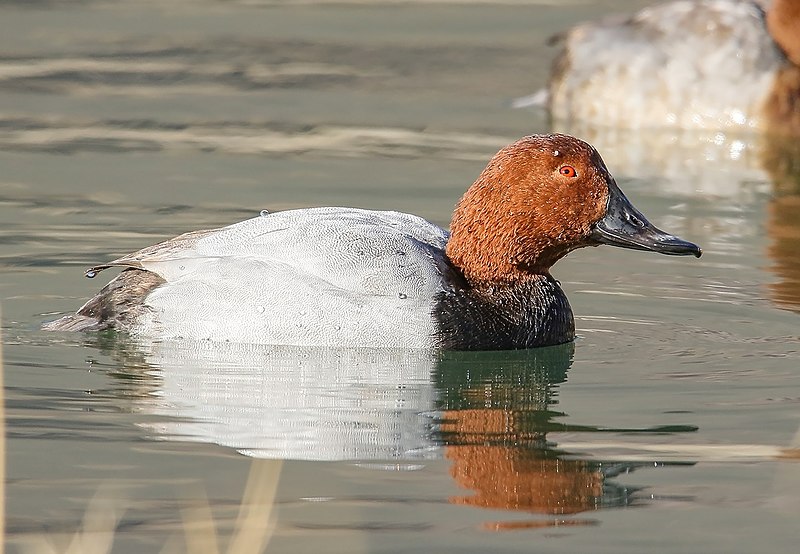
The Common Pochard is a medium-sized diving duck found across Eurasia and North Africa. It has distinctive features such as a long, dark bill with a grey band, red head and neck, black breast, red eyes and grey back.
The female has similar characteristics but her head is more brown/grey in colour than the male’s striking red hue.
They are often seen swimming together in large flocks near freshwater bodies or on lakes to feed on aquatic plants like seeds of waterlilies etc., which makes them an important part of the ecosystem by helping disperse plant species.
Their loud call can be heard over vast distances making them easy to spot even when they’re far away.Scientific classification:
| Kingdom | Animalia |
| Phylum | Chordata |
| Class | Aves |
| Order | Anseriformes |
| Family | Anatidae |
| Genus | Aythya |
| Species | A. ferina |
Also Featured In: Common Birds in Saudi Arabian, Native Birds of Kazakhstan
13. Common Redshank
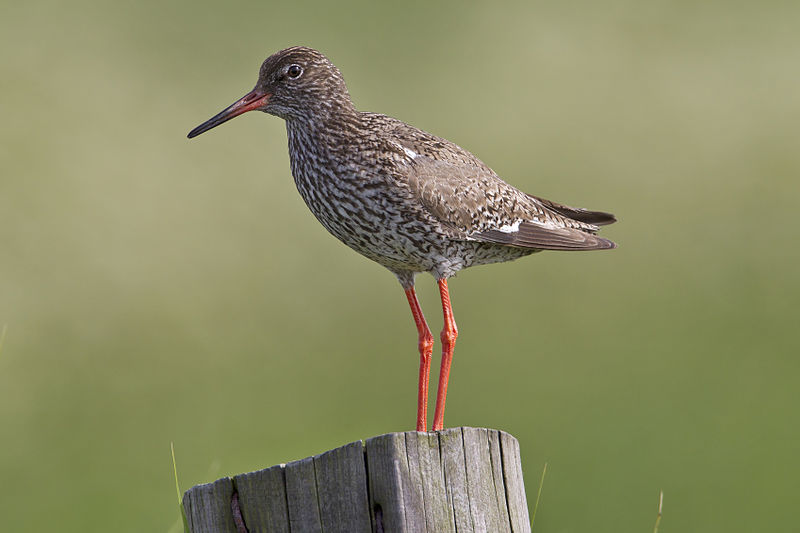
The Common Redshank is a wading bird found in Eurasia. It has long, red legs and dark grey wings. The body of the bird is brownish-grey with white patches on its sides and back.
Its bill is pointed and yellow to orange in colour, while its eyes are black or dark brown.
During migration they can be seen around coasts, estuaries and marshes where they feed mainly on small aquatic invertebrates such as worms, crustaceans and molluscs which it finds by probing mudflats with its bill.
They nest near wetland areas laying two to four eggs at a time during April or May depending on their location within Europe/Asia.
Redshanks often form large flocks when migrating southwards for wintering grounds in Africa or Asia making them easily visible from shorelinesScientific classification:
| Kingdom | Animalia |
| Phylum | Chordata |
| Class | Aves |
| Order | Charadriiformes |
| Family | Scolopacidae |
| Genus | Tringa |
| Species | T. totanus |
Also Featured In: Birds in Sri Lanka, Birds of Orkney
14. Black-Tailed Godwit
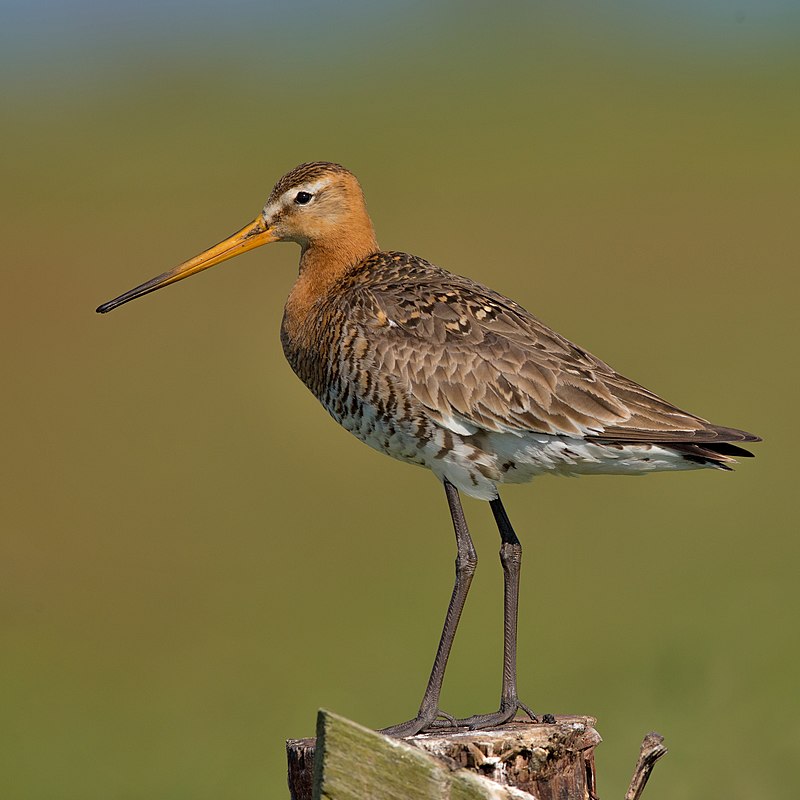
The Black-tailed Godwit is a species of large shorebird that was first described by Carl Linnaeus in 1758.
These beautiful birds have an orange head, neck and chest during breeding season while they turn to grey-brown coloration in winter.
They are easily identifiable due their black and white wingbar throughout the year. As for its habitat, these godwits breed mostly on Iceland but also across Europe, eastward through Asia Minor all the way to Mongolia; some even winter further south in Africa or India.
The Godwit has adapted well to human presence as it can be found close to wetlands near farms or villages where plenty of food is available from ploughed fields.
It’s really amazing how such a majestic bird with colorful plumage manages so successfully at this day and age.Scientific classification:
| Kingdom | Animalia |
| Phylum | Chordata |
| Class | Aves |
| Order | Charadriiformes |
| Family | Scolopacidae |
| Genus | Limosa |
| Species | L. limosa |
Also Featured In: Common Slovakian Birds, European Birds
15. Black-Crowned Night Heron
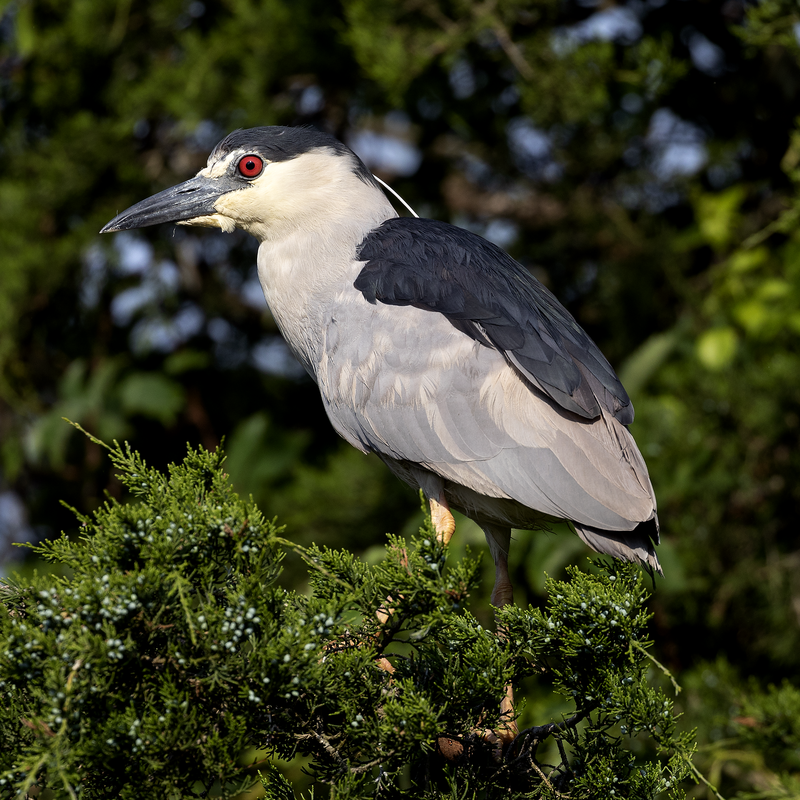
The Black-crowned night heron (Nycticorax nycticorax) is a medium-sized bird found in various parts of the world, including Europe, Asia and North and South America.
It has black crowns on its head with white feathers underneath. Its wings are greyish brown while its underparts are mostly white.
This species can be seen foraging near shallow water or along coastlines during dusk or dawn as it hunts small fish, amphibians and crustaceans.
They also feed on insects such as grasshoppers and beetles which they find in meadows close to freshwater bodies like lakes or ponds where they breed during springtime making nests using twigs lined with reeds and leaves near these waterside habitats.
In Australasia, this species hybridizes with the nankeen night heron that inhabits those areas instead; however both populations remain distinct from each other despite their overlap range regions.Scientific classification:
| Kingdom | Animalia |
| Phylum | Chordata |
| Class | Aves |
| Order | Pelecaniformes |
| Family | Ardeidae |
| Genus | Nycticorax |
| Species | N. nycticorax |
Also Featured In: Common Birds Found in Switzerland, Birds of Kauai, Hawaii
16. Grey-Headed Lapwing
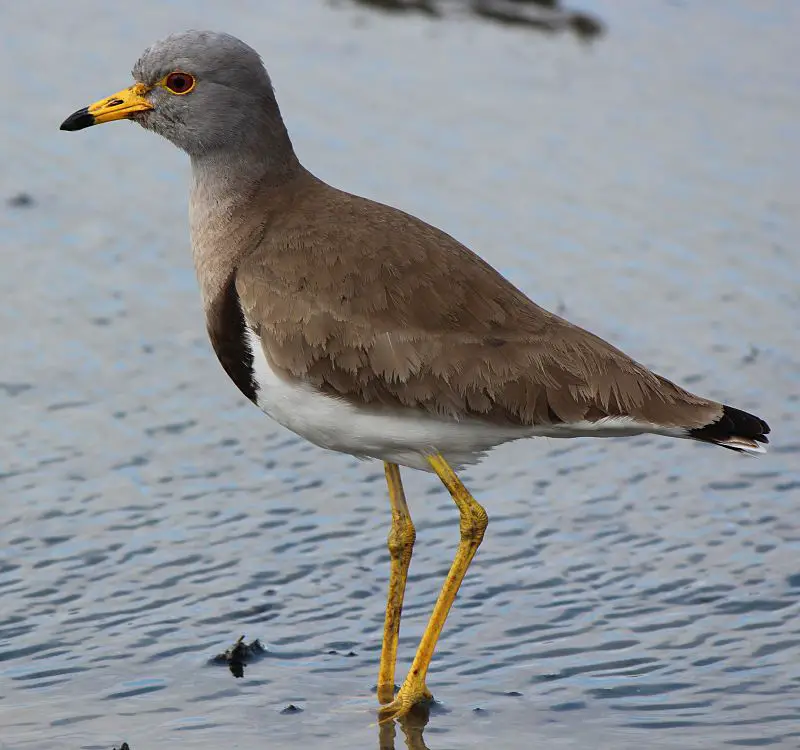
The Grey-headed Lapwing is a bird native to northeast China and Japan. During the winter season, they migrate to northern Southeast Asia from India all the way down to Cambodia.
The Japanese population has been known to spend some of their time in southern Honshū during this period as well.
It’s also classed as a vagrant species in several other countries such Russia, Philippines, Indonesia, Australia and Sri Lanka too.
This lovely little lapwing has grey feathers on its head along with white around its face and neck area which makes it easy for people to identify them if spotted out in nature.
They feed mainly off insects but have occasionally been seen eating plants or small seeds now and then too.Scientific classification:
| Kingdom | Animalia |
| Phylum | Chordata |
| Class | Aves |
| Order | Charadriiformes |
| Family | Charadriidae |
| Genus | Vanellus |
| Species | V. cinereus |
Also Featured In: Singapore Birds, Common Birds that Live in Odisha
17. Brown Shrike
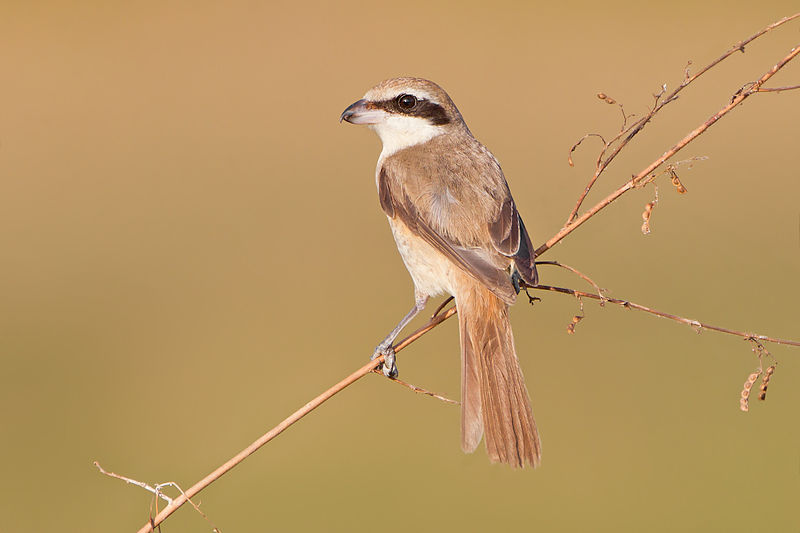
The Brown Shrike is a beautiful bird belonging to the shrike family, found mainly in Asia. It has a distinctive crest which gives it its Latin name ‘cristatus’.
They feed on insects and small vertebrates like lizards and mice, hence they are also called ‘butcher birds’.
These birds have brown upperparts with rufous wings, tail tipped white along with black mask through the eyes giving them an impressive look.
Despite their predatory nature these birds still remain quite popular amongst birdwatchers due to their vibrant colors and wide-ranging habitats across much of South East Asia making them easy targets for photography enthusiasts too.Scientific classification:
| Kingdom | Animalia |
| Phylum | Chordata |
| Class | Aves |
| Order | Passeriformes |
| Family | Laniidae |
| Genus | Lanius |
| Species | L. cristatus |
Also Featured In: Maldives birds, Common Philippines Birds
18. Little Grebe
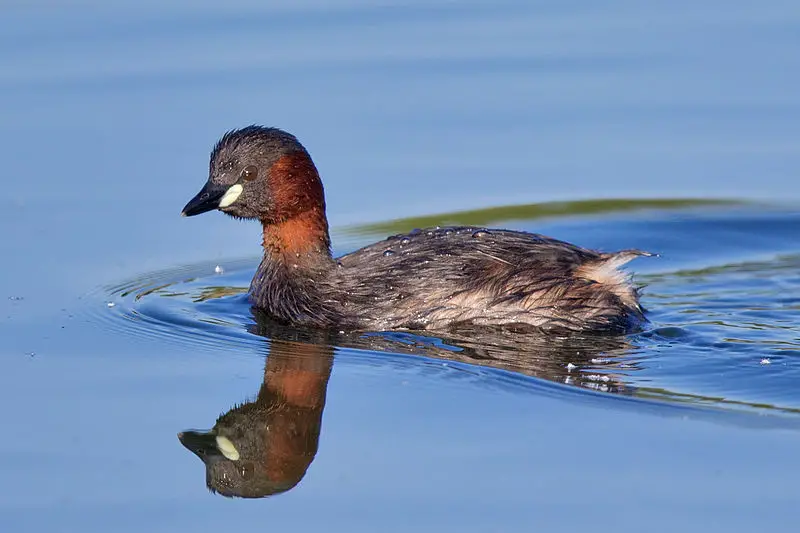
The little grebe, also known as dabchick, belongs to the grebe family and is a small water bird. It gets its genus name from the Ancient Greek words for ‘fast’ and ‘to sink under’.
The specific name ruficollis means ‘red-necked’ in Latin. With a length of 23 to 29 centimetres, it is the smallest member of the grebe family.Scientific classification:
| Kingdom | Animalia |
| Phylum | Chordata |
| Class | Aves |
| Order | Podicipediformes |
| Family | Podicipedidae |
| Genus | Tachybaptus |
| Species | T. ruficollis |
Also Featured In: Turkey Birds You Should Know, Italian Birds You Should Know
19. Greater Scaup
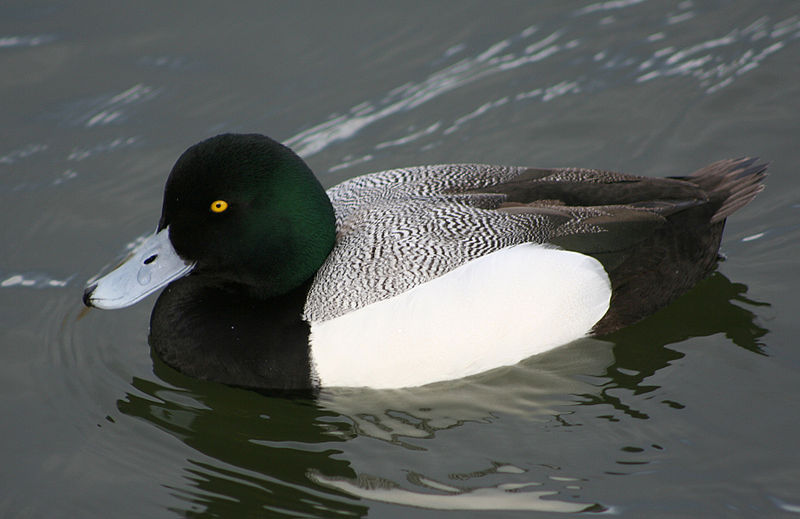
The greater scaup, commonly known as the bluebill in North America, is a medium-sized diving duck that breeds in the northernmost areas of the world including Alaska, northern Canada, and Siberia.
With its larger size, the greater scaup is distinguishable from its closely related cousin, the lesser scaup. During the winter months, it migrates to the coastal areas of North America, Japan, and Europe.
These ducks have a captivating blue-grey plumage with striking yellow eyes. They are excellent divers, often feeding on mollusks, crustaceans, and aquatic plants found in deep waters.
Unfortunately, their populations have declined mainly due to habitat loss from agricultural activities and pollution.
Conservation efforts such as habitat protection and hunting regulations are being implemented to save these remarkable birds.Scientific classification:
| Kingdom | Animalia |
| Phylum | Chordata |
| Class | Aves |
| Order | Anseriformes |
| Family | Anatidae |
| Genus | Aythya |
| Species | A. marila |
Also Featured In: Most Common Lake Birds, Native Birds Of Winter Island
20. Eurasian Wigeon
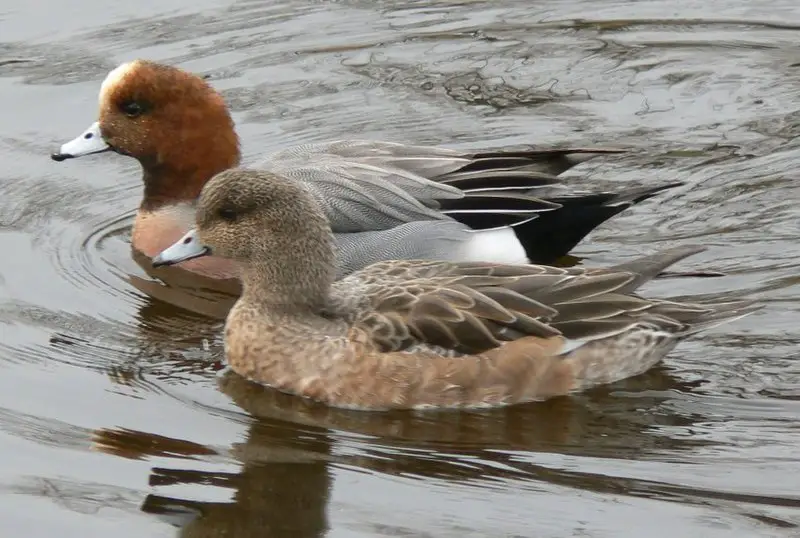
The Eurasian wigeon, also known as the widgeon, is a dabbling duck found throughout its Palearctic range. This species belongs to the genus Mareca and is one of three species of wigeons.
Carl Linnaeus described the Eurasian wigeon in 1758 under the binomial name Anas penelope. This bird is common and widespread across its range.
The Eurasian wigeon is a beautiful bird with a distinctive yellow forecrown, pink breast, and gray-blue beak, and is known for its whistling call.
They are often found in wetlands, where they feed on aquatic plants and invertebrates. The male has a striking breeding plumage, with a chestnut head and neck, gray body, and black-and-white wings.
The female is less colorful, with a brown head and a mottled brown body. This bird is important for both its ecological and cultural value.Scientific classification:
| Kingdom | Animalia |
| Phylum | Chordata |
| Class | Aves |
| Order | Anseriformes |
| Family | Anatidae |
| Genus | Mareca |
| Species | M. penelope |
Also Featured In: Birds that Commonly Found in Pond , Tokyo Birds You Need to Know
21. Red-Necked Stint
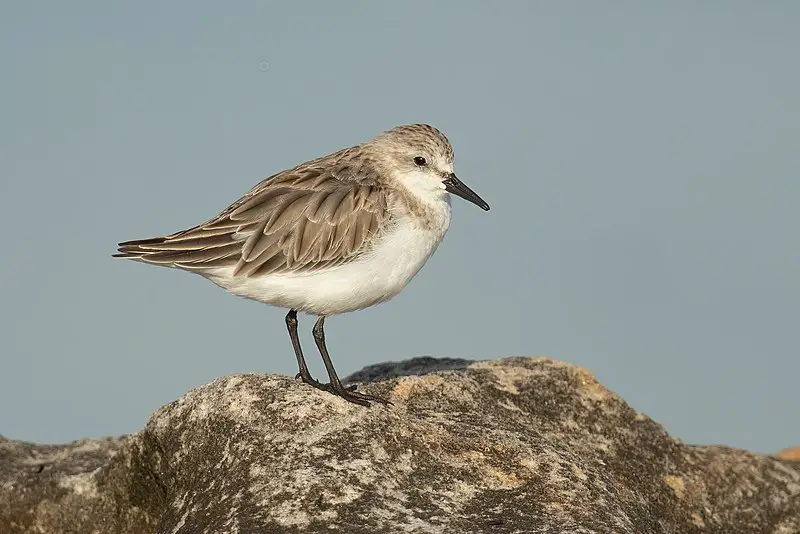
The Red-necked stint is a migratory wader known for its small size. It is often compared to the Little stint due to its similar appearance.
The bird’s genus name, Calidris, refers to grey-coloured waterside birds, according to Aristotle.
The Latin word rufus, meaning “red,” and collum, meaning “neck,” comprise the bird’s specific name ruficollis.
These tiny birds are known for their vibrant colors and are easily recognizable due to their distinct red necks.
They are also known for their remarkable migration patterns, flying long distances during breeding and non-breeding seasons.
Despite their small stature, Red-necked stints are impressive birds with a fascinating history.Scientific classification:
| Kingdom | Animalia |
| Phylum | Chordata |
| Class | Aves |
| Order | Charadriiformes |
| Family | Scolopacidae |
| Genus | Calidris |
| Species | C. ruficollis |
Also Featured In: Birds of Tasmania, New South Wales Birds You Need to See
22. Eastern Spot-Billed Duck
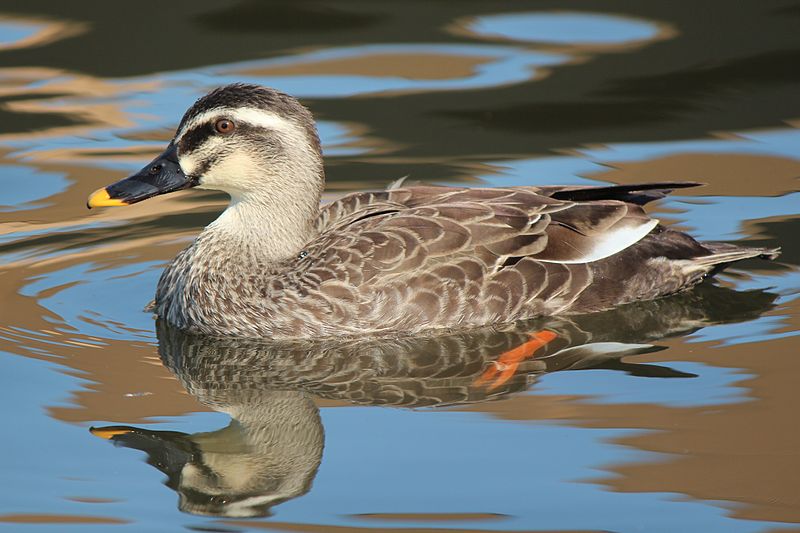
The Eastern Spot-Billed Duck is a dabbling bird that is found in East and Southeast Asia. It was once considered a subspecies of the Indian Spot-Billed Duck, but is now recognized as a separate species.
The name of the bird comes from the yellow spot on its bill. This bird breeds in various areas across its range and is known for its distinctive plumage, which includes a subtle blend of brown, gray, and white feathers.
The Eastern Spot-Billed Duck is a common sight in many wetland habitats and can often be seen swimming in small flocks.
This duck species has a characteristic quacking sound, and it feeds mainly on small aquatic plants, mollusks, and invertebrates.
Overall, the Eastern Spot-Billed Duck is an interesting and unique bird that is worth observing in the wild.Scientific classification:
| Kingdom | Animalia |
| Phylum | Chordata |
| Class | Aves |
| Order | Anseriformes |
| Family | Anatidae |
| Genus | Anas |
| Species | A. zonorhyncha |
23. Long-Billed Plover
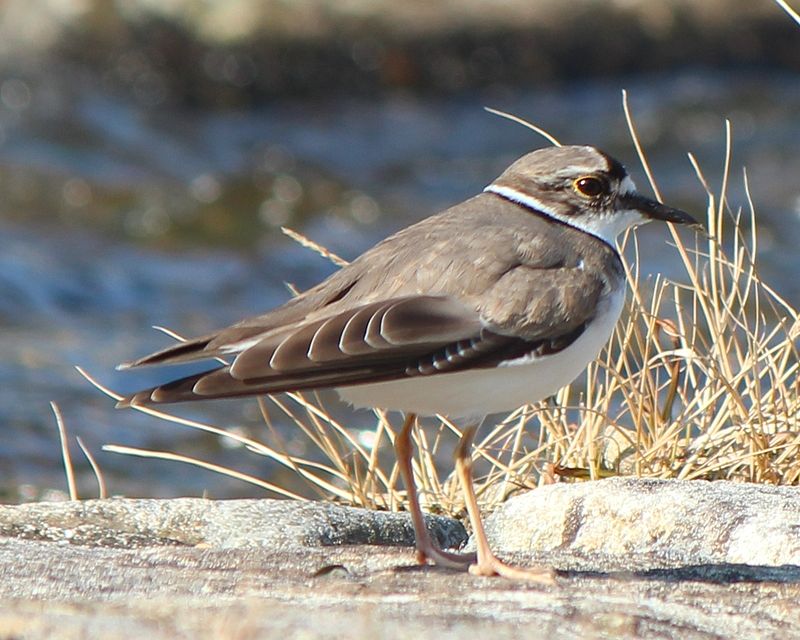
The Long-billed plover is a migratory bird found across Asia, breeding and spending winters in various countries. Belonging to the Charadriidae family, it is a wading bird with a distinctively long bill.
Its habitat includes wetlands, coastal areas, and sandy or muddy plains. During the breeding season, the male has a striking black and white plumage, while the female has a duller brown and white coloration.
They are known for their sharp, piercing calls that can be heard from a distance. These birds mainly feed on insects, crustaceans, and other small invertebrates found in their habitat.
Despite being a widespread species, they face threats from habitat destruction, illegal hunting, and pollution.
Conservation efforts are necessary to ensure the survival of this beautiful bird.Scientific classification:
| Kingdom | Animalia |
| Phylum | Chordata |
| Class | Aves |
| Order | Charadriiformes |
| Family | Charadriidae |
| Genus | Charadrius |
| Species | C. placidus |